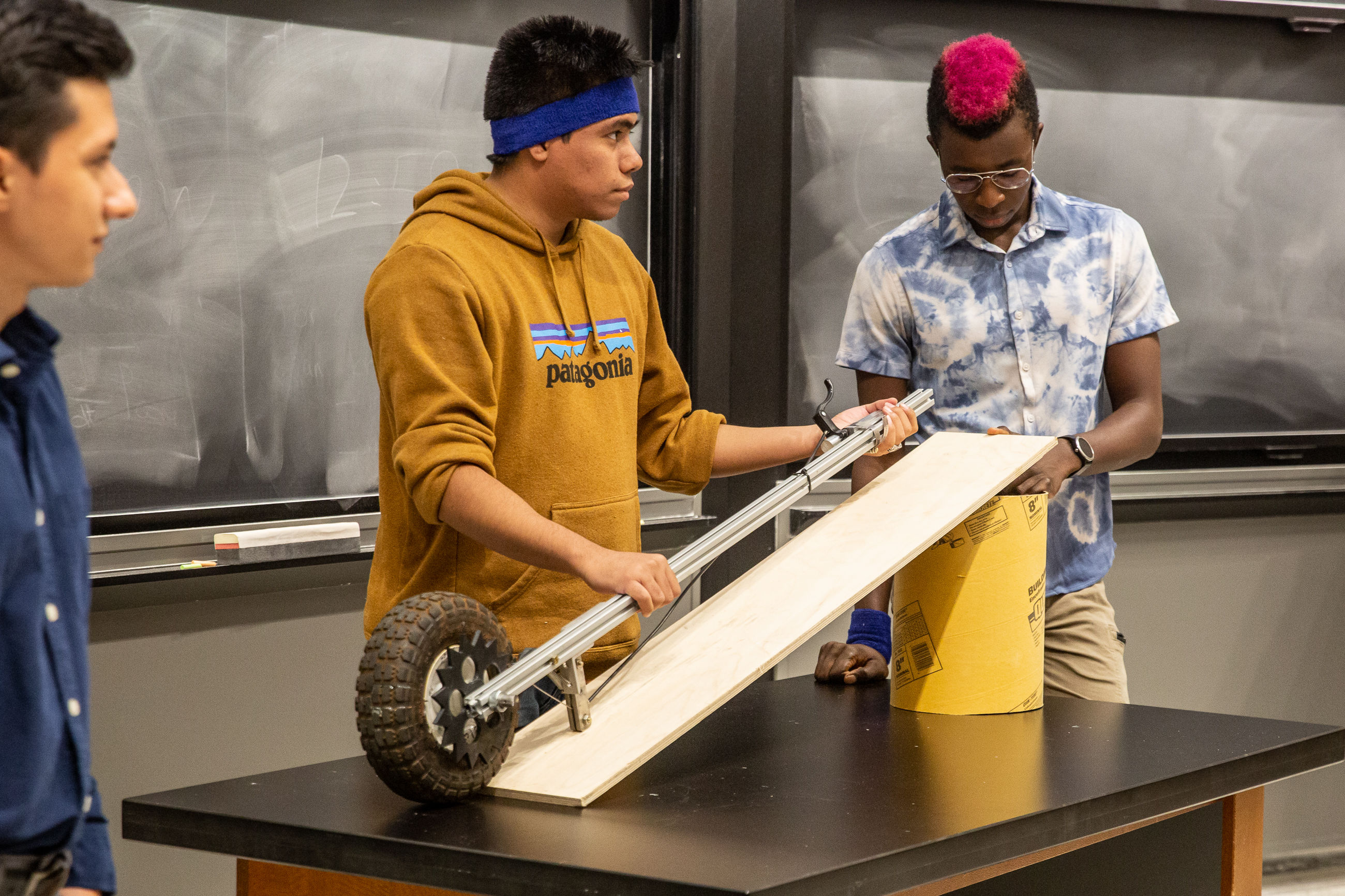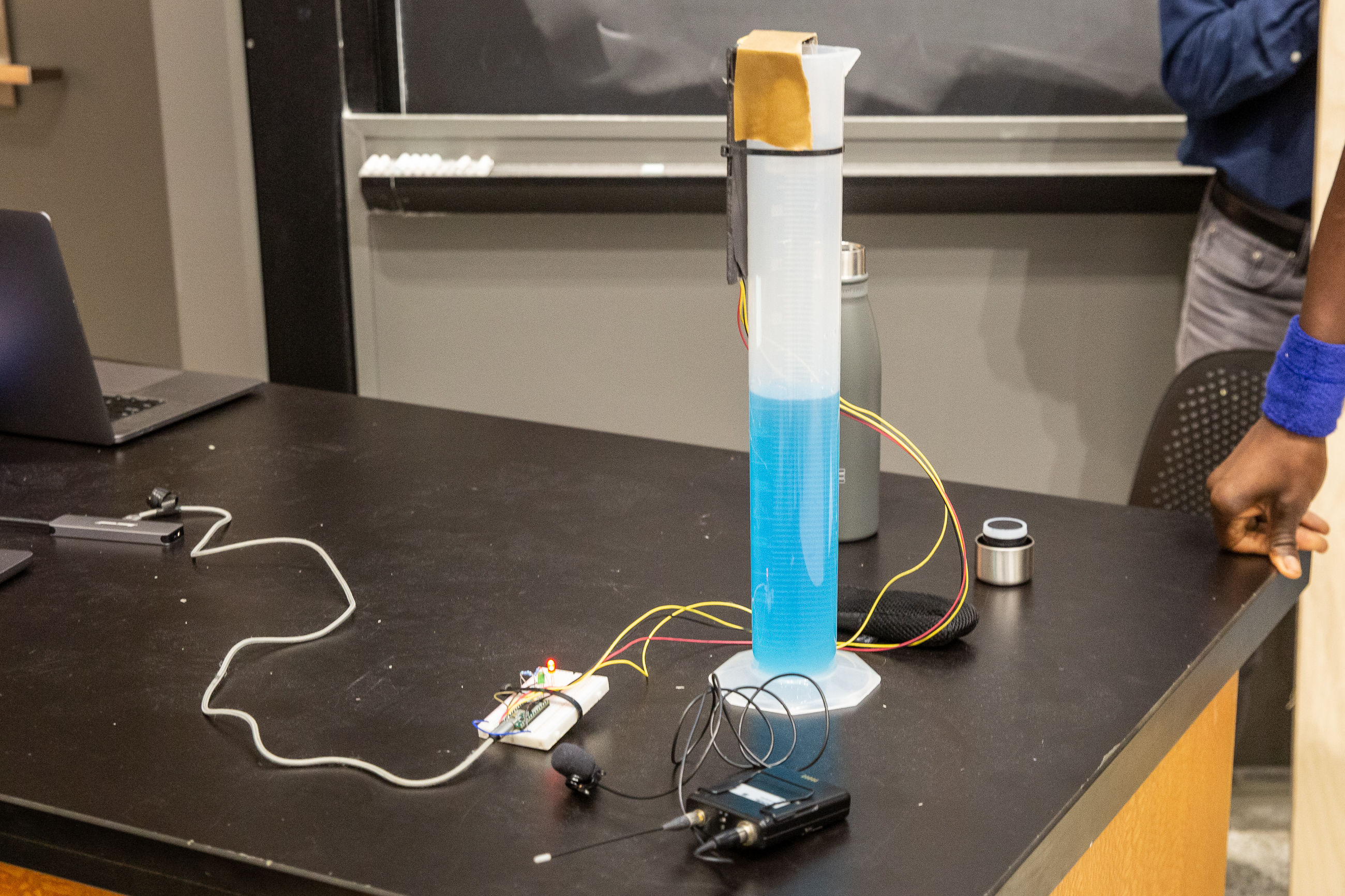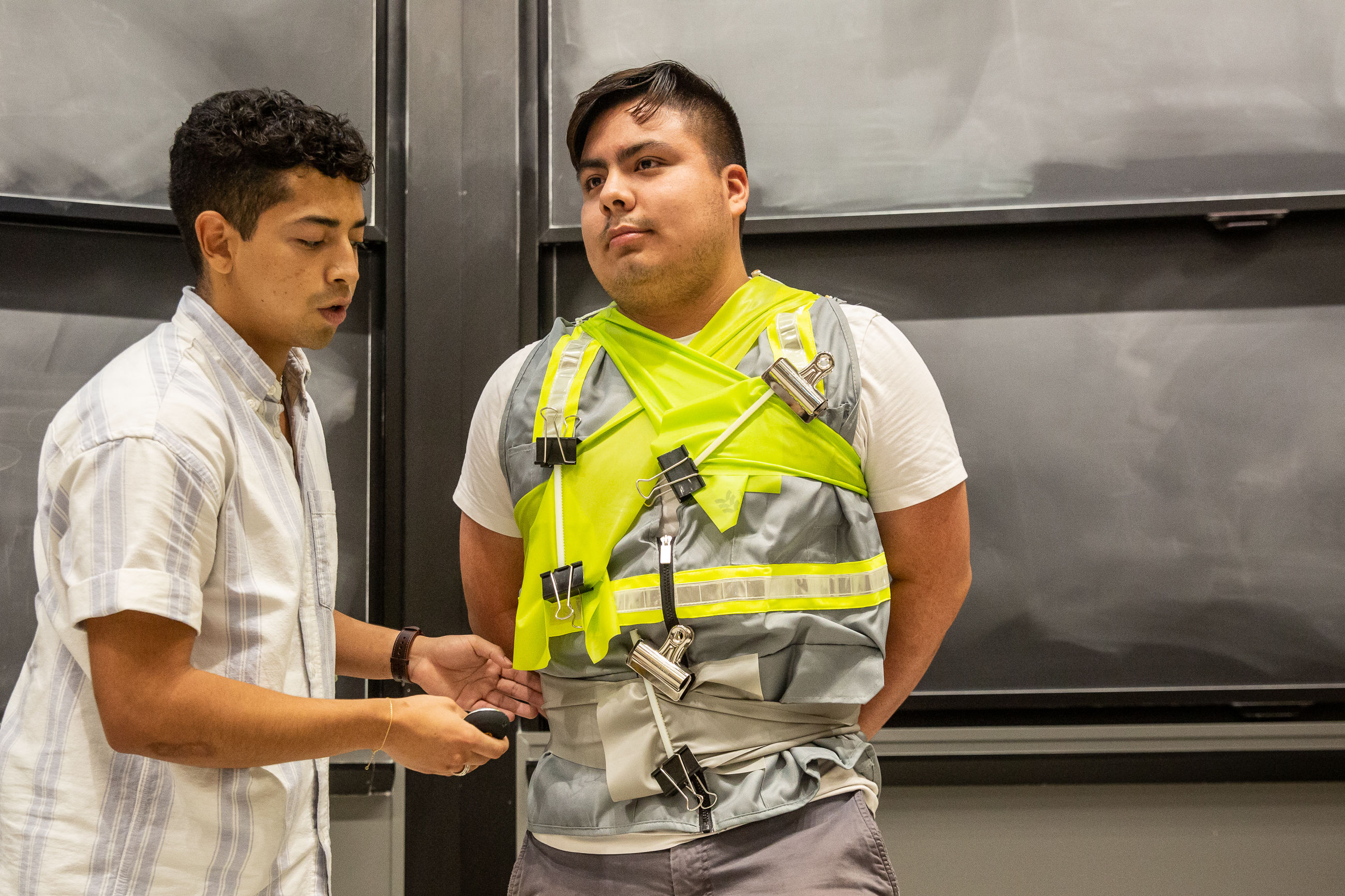Blue Team!
Sketch Models!
View the 4 Presentation Slides (.pdf)
Presentation Video
Concepts
Ratcheting Hand Truck
Handtruck with a toggleable ratcheting mechanism that allows it to move in one direction but not the other.


Reviewer Feedback
Liz Stevens (Communication Instructor)
Product Opportunity
Great presentation - seemless! Delivery workers are essential, and their work is physically exhausting. I know someone who has worked for Amazon as a delivery driver, and it's intense. This user need is very convincing, especially with delivery companies making malls and big box stores obsolete.
Product Embodiment
Great rhetoric here to highlight the benefit to users ("Helping delivery workers to save their backs"). I am wondering if the hand cart rolling back down the ramp is really the biggest pain point that the delivery worker encounters. Or, is the force required to pull the load up the truck still exhausting, even with the brake? Can the worker use the same cart to go back down the ramp? Does the hand brake help make it easier to go down? Or does the extra act of squeezing the break add to the exhaustion? And does the cognitive load become greater? Carts are intuitive - push or pull - but when you introduce a hand break, does it become harder to use? Would that be a barrier to adoption?
Model Learnings
Your model demonstrated the concept could work very simply and cleanly.
Model Execution
You've started to answer the question of whether this is feasible. More user interviews will help extend whether the brake will help with some of delivery workers' main pain points.
Juhan Sonin
Product Opportunity
Feedback all in 1 PDF: https://www.dropbox.com/s/3q8l2fdxbdftlsc/MIT2009_Blue_SketchModel_Feedback_Sonin_Fall2022.pdf?dl=0
Product Embodiment
No feedback provided
Model Learnings
No feedback provided
Model Execution
No feedback provided
Adam Frick
Product Opportunity
The problem is clearly established as hand trucks being difficult to maneuver up ramps due to the added weight, how does a ratcheting system address this? This appears to be a safety device to prevent slip more than an assistive device for heavy loads.
Product Embodiment
Does engaging the ratcheting system add extra resistance to the wheels when in use? If so, then would users prefer to keep it off most of the time? Maybe the function of the handle should either be reversed or latched
Model Learnings
No feedback provided
Model Execution
No feedback provided
Peter Nielsen
Product Opportunity
While there is a demonstrable user need an incremental - rather than absolute - brake may be a better solution.
Product Embodiment
There was no actual product - the model was a fair test of the imagined device itself.
Model Learnings
Ratchet stops work - a bit more exploration of how to implement it onto a hand truck may have added value
Model Execution
That depends on the question - how many teeth, what loading they might see, material selection - all up for investigation
April Anlage
Product Opportunity
Are you able to quantify injuries or describe user complaints about this problem? Certainly hand trucks are used frequently, but what is the extent of the problem you are trying to solve?
Product Embodiment
Are there other pain points you can additionally address with your product? The ratcheting mechanism is fairly straightforward, this might be an opportunity to explore the space further.
Model Learnings
What was the key question you were trying to answer? I'm not sure how the key learnings on your slides relate to your sketch model, beyond making the ratchet function.
Model Execution
See above, not sure what the key questions are.
Drowning Alert
Decive that automatically alerts parents when their children are risking drowning in the pool.


Reviewer Feedback
Liz Stevens (Communication Instructor)
Product Opportunity
Great slides - the visual design is very compelling! I just spent the weekend at an indoor waterpark, and I'm exhausted from watching my kid swim, go under water, and come back up 10,000 times. There is a clear user need for a drowning alert system.
Product Embodiment
Clear and logical narrative. It seems like a nice addition to "watching your kid like a hawk" in the pool.
Model Learnings
You asked the right questions, and clearly presented your results.
Model Execution
Did you get any real world data on drownings? How do we know that time and depth are a reliable indicator of distress in the water? In the water park, the water was less than 3 feet high, but it's still possible to drown in shallow water.
Adam Frick
Product Opportunity
This would not cover cases where children fall in accidentally or swim unsupervised without proper preparation - is there a strong user need outside of these scenarios?
Product Embodiment
No feedback provided
Model Learnings
How did you determine duration and depth were indicative of distress, and how did you determine the thresholds? Have you looked into correlation with motion or pulse? (these could all potentially be sensed on an anklet)
Model Execution
No feedback provided
Peter Nielsen
Product Opportunity
The need is real. Many variables in the user space make the problem challenging.
Product Embodiment
I don't see how an ankle-based device and reliably indicate a status change, for example from playing impromptu water volleyball to staying underwater in a stress situation. Water transmits sound but directionality can be lost, and a light in a crowded pool may not be seen. One presumes a drowning person is stressed - pulse or breathing rate monitoring?
Model Learnings
The model did not really capture the larger questions.
Model Execution
The applicable sensors work - the real task is implementation into a viable application match. Next steps might be to investigate power, signal strength and resultant size/weight parameters, converge on a realistic product vision.
April Anlage
Product Opportunity
Accident prevention is an interesting space, as many people may believe accidents like drowning won't happen to them and are uninvested in actively seeking products to prevent it. Accidental drowning is certainly a problem, but are you able to identify how much active demand there is for a product to prevent it?
Product Embodiment
A number of challenges here including reliability of drowning detection (does depth/time really indicate drowning, effectiveness of alert, specific depth/time of alert, etc.
Model Learnings
Good job stating your key question, but I'm not convinced drowning and depth/time are necessarily correlated (in either direction - someone could be purposefully diving and totally fine or drowning quite close to the surface/with their feet pointing upwards).
Model Execution
Unclear how your pressure sensor sketch model is indicative of drowning.
Anti Panic Attack Vest
Vest that calms users experiencing a panic attach


Reviewer Feedback
Liz Stevens (Communication Instructor)
Product Opportunity
Really effective slide design and storytelling. With mental health at an all time low, this fills a very real user need. I think people want a non-pharmaceutical way to treat panic attacks, like vagus nerve stimulation (cold pack on the chest) or breathing exercises that is easy and effective.
Product Embodiment
You seem to have a good sense of what is lacking in previous models. A vest does seem like a good idea, because it reinforces calming for many reasons (placebo effect, pavlovian conditioned response, and real physical benefit of pressure like the "thunder vest").
Model Learnings
Good questions. It does seem difficult to conceal a vest with these features, but people conceal bullet-proof vests and spanx all the time. Would it be comfortable?
Model Execution
What kind of pressure point stimulation will the vest offer, and is there evidence that this kind works to control panic attacks?
Adam Frick
Product Opportunity
Why were existing products not suitable for daily use? Is the target user a subset of users that experience panic attacks of this frequency? I'm wondering if this is too narrow of a market
Product Embodiment
What value does automatic activation add to this product? Will users be unable or unwilling to activate it on their own? Considering the ambiguity of distinguishing a panic attack from exercise with vital sensors, this may benefit from a different approach
Model Learnings
No feedback provided
Model Execution
No feedback provided
Peter Nielsen
Product Opportunity
The problem is real, may benefit from a more global exploration.
Product Embodiment
Next steps might be to investigate power, compressor (or compressed air storage) and resultant size/weight parameters, converge on a realistic product vision. Could several small motors in a cable-based system package better?
Model Learnings
Unknown. It is acknowledged that a pressure application can have a calming effect; how best to do that?
Model Execution
A few pressure sensors under the device might begin a path to some quantification of the challenge.
April Anlage
Product Opportunity
You mention the various treatments for a panic attack - how did you identify this problem as a pain point? (i.e. panic attacks are bad, but are current remedies falling short?)
Product Embodiment
A concern with automated detection - how does it differentiate a panic attack from other daily stressors? I see this is what is differentiating your product from others on the market, but you haven't convinced me this is a needed feature - is having to activate other vests a major pain point?
Model Learnings
No feedback provided
Model Execution
I wasn't clear on how your model provided the pressure - was it a looks like model (please demo on the model!)? How did you measure the pressure applied?
Flexibelly
Adaptable and adjustable support device for pregnant women experiencing back pain


Reviewer Feedback
Liz Stevens (Communication Instructor)
Product Opportunity
Great presentation - the delivery was on point! This is a clear user need to help women keep going when they are pregnant. When I was pregnant I tried bands, but they were difficult to position and uncomfortable. Maternity jeans with an elastic waist were much more helpful for a long work day. The trade off between flexibility and support was very well presented.
Product Embodiment
I didn't quite see how the new model is more adjustable than the models currently available. They all have velcro so you can adjust the width, and you can slide them up or down.
Model Learnings
I think a critical question is: what does the belt look like? Is it like the example in the benchmarks with suspenders? Or a simple band?
Model Execution
How does the band expand? I didn't get a clear idea of the design.
Juhan Sonin
Product Opportunity
No feedback provided
Product Embodiment
No feedback provided
Model Learnings
No feedback provided
Model Execution
Feedback all in 1 PDF: https://www.dropbox.com/s/3q8l2fdxbdftlsc/MIT2009_Blue_SketchModel_Feedback_Sonin_Fall2022.pdf?dl=0
Adam Frick
Product Opportunity
No feedback provided
Product Embodiment
Aside from flexibility, does this address any other issues you've mentioned with existing supports? Is this meant to be worn externally?
Model Learnings
No feedback provided
Model Execution
Is it more difficult to re-apply the zipper due to elasticity/angle? Is there concern about the strap shifting around?
Peter Nielsen
Product Opportunity
Absolutely, a real need.
Product Embodiment
Is a simple two stage implementation preferable to a multi-adjustable piece? A zipper under lateral stress is probably not the optimal adjustment methodology - a velcro strap on a return may allow more comfort and easier use.
Model Learnings
Perhaps the team could experiment with much heavier objects to more realistically simulate the challenge
Model Execution
The model is a start to a much larger exploration.
April Anlage
Product Opportunity
You did a good job of motivating the problem and clearly stating the 3 problems with current options.
Product Embodiment
Not entirely clear how this is differentiated from current products - it would have been useful to see the sketch model in action (standing/sitting).
Model Learnings
No feedback provided
Model Execution
Not sure how your model related to your key learnings.